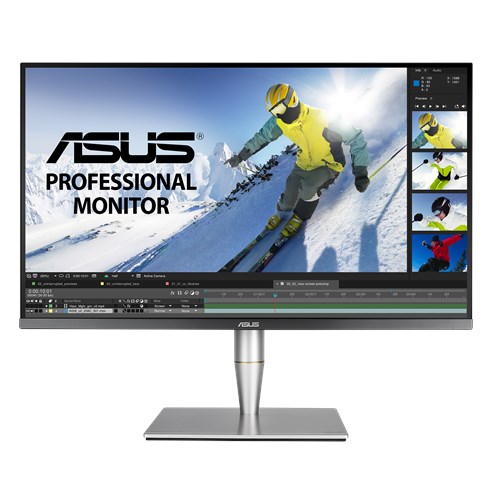-ASUS ProArt PA32UC Professional Monitor - 32 inch, 4K, HDR, direct-LED, Local Dimming, 85% of Rec.2020, 95% of DCI-P3, Hardware Calibration, Thunderbolt™ 3
-Optimized 384 zones direct-LED backlight matrix support and ASUS LED driving technology achieves 1 micro second operation for better HDR performance (1000 cd/m², peak)
-Powerful interface with Intel Thunderbolt™ 3, DP and HDMI I/O easily connecting to various devices
-Wide Color Gamut technlogy reproduces 85% of Rec.2020, 99.5% of Adobe RGB, 95% of DCI-P3 & 100% of sRGB color space
-Factory pre-calibrated, with ASUS ProArt™ Calibration Technology to ensure color accuracy during different using scenarios
-ASUS Eye Care monitors feature TÜV Rheinland-certified Flicker-free and Low Blue Light technologies to ensure a comfortable viewing experience

Panel Size: Wide Screen 32” (81.28cm) 16:9
Color Saturation : 85% Rec.2020, 99.5% Adobe RGB, over 95% DCI-P3 and 100% sRGB
Panel Type : IPS
True Resolution : 3840x2160
Display Surface Non-glare
Pixel Pitch : 0.1845/ mm
Brightness(Max) : 1000 cd/㎡
Contrast Ratio (Max) : 1000:1
Viewing Angle (CR≧10) : 178°(H)/178°(V)
Response Time : 5ms (Gray to Gray)
Display Colors : 1.07 Billion
Flicker free
LCD ZBD Warranty : Yes
HDR (High Dynamic Range) Support : Yes
Dynamically Local Dimming : Yes, 384 Zones
http://dlcdnet.asus.com/pub/ASUS/LCD Monitors/PA32U/PA32U_English.pdf
Reading the owners manual it appears to have some nice features:
1. Motion Sync: Simulates display as high refresh rate performance to
generate different backlight frequencies
2. Adaptive-Sync can only be activated within 40Hz ~ 60Hz.
3. Dynamic Dimming: Synchronizes with contents while contrast changing
to execute backlight dynamic dimming .
• To activate this function, you need to do the following: turn off PIP/PBP.
• Dynamic Dimming is automatically activated when HDR is on.
I would take that to read that it is the first monitor that can utilize the FALD back-light on non-HDR content.
4. HDR:
* “HDR 1” .
* “HDR 2” complies with ULTRA HD PREMIUM™
5. Brightness 400 cd/m2 (Typ.), 1000 cd/m2 (Max.)
https://www.bhphotovideo.com/bnh/controller/home?O=email&A=details&Q=&sku=1380030&is=REG
-Optimized 384 zones direct-LED backlight matrix support and ASUS LED driving technology achieves 1 micro second operation for better HDR performance (1000 cd/m², peak)
-Powerful interface with Intel Thunderbolt™ 3, DP and HDMI I/O easily connecting to various devices
-Wide Color Gamut technlogy reproduces 85% of Rec.2020, 99.5% of Adobe RGB, 95% of DCI-P3 & 100% of sRGB color space
-Factory pre-calibrated, with ASUS ProArt™ Calibration Technology to ensure color accuracy during different using scenarios
-ASUS Eye Care monitors feature TÜV Rheinland-certified Flicker-free and Low Blue Light technologies to ensure a comfortable viewing experience

Panel Size: Wide Screen 32” (81.28cm) 16:9
Color Saturation : 85% Rec.2020, 99.5% Adobe RGB, over 95% DCI-P3 and 100% sRGB
Panel Type : IPS
True Resolution : 3840x2160
Display Surface Non-glare
Pixel Pitch : 0.1845/ mm
Brightness(Max) : 1000 cd/㎡
Contrast Ratio (Max) : 1000:1
Viewing Angle (CR≧10) : 178°(H)/178°(V)
Response Time : 5ms (Gray to Gray)
Display Colors : 1.07 Billion
Flicker free
LCD ZBD Warranty : Yes
HDR (High Dynamic Range) Support : Yes
Dynamically Local Dimming : Yes, 384 Zones
http://dlcdnet.asus.com/pub/ASUS/LCD Monitors/PA32U/PA32U_English.pdf
Reading the owners manual it appears to have some nice features:
1. Motion Sync: Simulates display as high refresh rate performance to
generate different backlight frequencies
2. Adaptive-Sync can only be activated within 40Hz ~ 60Hz.
3. Dynamic Dimming: Synchronizes with contents while contrast changing
to execute backlight dynamic dimming .
• To activate this function, you need to do the following: turn off PIP/PBP.
• Dynamic Dimming is automatically activated when HDR is on.
I would take that to read that it is the first monitor that can utilize the FALD back-light on non-HDR content.
4. HDR:
* “HDR 1” .
* “HDR 2” complies with ULTRA HD PREMIUM™
5. Brightness 400 cd/m2 (Typ.), 1000 cd/m2 (Max.)
https://www.bhphotovideo.com/bnh/controller/home?O=email&A=details&Q=&sku=1380030&is=REG
![[H]ard|Forum](/styles/hardforum/xenforo/logo_dark.png)


